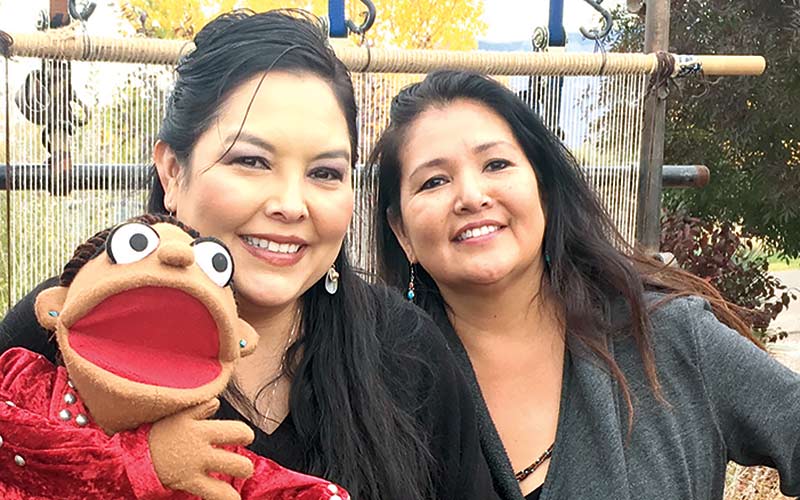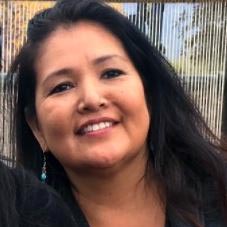
Guest Column: A Native American ‘Sesame Street’ could help save dying languages

Courtesy photo From left to right, Dine Bi Na'Alkid Time puppet Nanabah, who is fluent in Navajo, with co-writers Shawna Begay and Charmaine Jackson.
By Charmaine Jackson
Although I grew up in Shiprock, N.M., on the Navajo reservation, both my parents were forced to attend boarding schools in the 1950s and were not allowed to speak their own Navajo, or Diné, language.

Charmaine Jackson is executive producer and co-writer of Diné Bí Ná’álkid Time.
Like many Navajo tribal members, my parents, Robert and Genevieve Jackson, were traumatized by the experience of being abused or punished if they spoke Navajo. I wasn’t raised to speak my language, my parents told me, so that I would be more successful in life.
Growing up, I was slightly jealous of my cousins who were fluent in both Diné and English. My grandma Rose Jackson used to tell me I had only one ear and that was for English. And during my childhood, many other Navajo kids in school didn’t speak Diné either. Because it was important to me I took Navajo language classes at the University of New Mexico in 1998, and even then it was considered a foreign language.
Today my language, like most indigenous languages, is in danger of being lost. And yet, our language plays a significant role in American history. “Code talkers” who spoke Diné secretly transmitted messages for the U.S. military during World War II. The 13 surviving code talkers were recently honored at the White House. The decline of the Navajo language further damages our place in American culture, and it portends the loss of our stories, traditions and history, as well.
Focusing on children is crucial to saving the Diné language. While there are 7,600 traditional Diné-only speakers and about 169,000 Navajo-English fluent speakers still in the United States, the language will not survive if children are not learning it. Just as we help children learn English and Spanish through educational programs like “Sesame Street,” shouldn’t we do the same with Native American languages?
Being Navajo or Diné, which means, ‘the people,’ also comes with a long history of assimilation, discrimination and annihilation of a race of people. Our Diné language, given to us by the Holy People, is sacred. Like most natives who have survived today, I describe it as walking in two worlds, the traditional world and the modern world.
We have over 300,000 Navajo enrolled tribal members who live on and off the largest Native American reservation, or land base, in North America. Our land extends into three states, New Mexico, Arizona and Utah, and is larger than most East Coast states.
One of the obstacles I found in my quest to learn my language was finding other people with whom to speak it fluently on a daily basis when living in a big city or even visiting our homeland.
My dear friend and colleague, Shawna L. Begay, who also grew up on the reservation in Window Rock, Ariz., didn’t learn to speak our language either.
“I never learned the Navajo language and I was never inspired to learn the Navajo language as a child,” she told me. “As I got older, I realized how valuable our language is to the livelihood of our Navajo Nation.”
Shawna and I met at the 2007 Sundance Film Festival, when she was a reporter for the Navajo Times. She was interviewing me about my role as a Navajo-speaking woman in the short film “Conversion.” Ironically, it was about how religious missionaries scoured New Mexico, Utah and Arizona tribal lands trying to convert Navajos and other Native nations they came across to Mormonism or Christianity.
Several years later we ran into each other again while working for the Navajo Nation government. Shawna told me she was going to return to school to get her doctoral degree to learn more about saving our Diné language. Her doctoral thesis was “Developing a Navajo Media Guide: A Community Perspective,” which focused on our Diné language, and our cultural and traditional ways. We had talked about her idea for developing a TV puppet show to help children learn our Navajo language, culture and traditions. Her research, the first of its kind, gave us a foundation to fulfill our dreams.
So we teamed up to produce the first-ever Navajo puppets TV show called “Diné Bí Ná’álkid Time” or “The Navajo Movie Time.” It is geared toward 4- to 6-year-old preschool students to teach them the Navajo language. We will use puppets created by Navajo artist Jason Barnes, including Nanabah, a 5-year girl; Gah, the Diné word for rabbit, and Dlóó, which means prairie dog, along with other animal characters. The show will chronicle their adventures throughout Navajoland. We’ve launched a GoFundMe page to help raise money for the project.
We both believe that media is a powerful tool that can be used to teach school-aged children and practically anyone interested learning the Navajo language. In today’s digital age there are multiple opportunities to utilize social media to document our history and revitalize the Navajo language.
If you look around, you will see kids on cellphones and tablets, watching television and YouTube. Their constant use of digital media convinced us that it is the easiest way to teach and reach our youth today.
“Media has become the new form of storytelling and through it we can achieve learning objectives,” Shawna concluded. “Mass media has been seen as detrimental to indigenous ways of life by taking away precious time from learning from elders. As our different cultures grow and change, adaptations can occur to ensure the survival of indigenous languages.”
Through both our modern and cultural experiences over the years, this project has brought us back together and we are determined to help save our Diné language for our elders, families, youth and our future. We hope our story will inspire our Diné tribal members and other indigenous peoples to become involved in saving all our ancestral languages.
Editor’s Note: A version of this column appeared in the December 8 edition of The Washington Post and is reprinted here with the author’s permission.
To read the full article, pick up your copy of the Navajo Times at your nearest newsstand Thursday mornings!
Are you a digital subscriber? Read the most recent three weeks of stories by logging in to your online account.








 Highway 264,
Highway 264, I-40, WB @ Winslow
I-40, WB @ Winslow